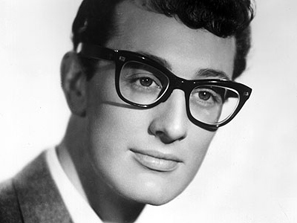5 reasons why Buddy Holly is still cool
MusicRadar salutes a genuine trailblazer

Today (3 February) marks 53 years since the tragic, untimely death of Buddy Holly in a plane crash that also claimed the lives of Ritchie Valens, The Big Bopper and pilot Roger Peterson.
Despite a painfully brief recording career that lasted just three years, Holly - real name Charles Hardin Holley - changed the landscape of popular music forever.
Here are five reasons why Buddy Holly still matters in 2012…
1. Buddy Holly influenced the greatest bands of all time
Buddy Holly was a huge influence on The Beatles in their formative years and his hold over John Lennon would continue throughout his solo career in the 1970s.
The 1995 Anthology series unearthed Lennon, McCartney and Harrison's first ever studio recording - a cover of That'll Be The Day recorded as The Quarry Men - and they would perform numerous Holly songs during their time in Hamburg, later recording Crying, Waiting, Hoping and Words Of Love. Paul McCartney now owns the publishing rights to Holly's song catalogue.
Meanwhile, a teenage Keith Richards witnessed Holly play live on his 1958 UK tour, and The Rolling Stones went on to release perhaps the definitive Buddy Holly cover version.
Here's The Stones' rip-roaring version of Not Fade Away from 1964:
Get the MusicRadar Newsletter
Want all the hottest music and gear news, reviews, deals, features and more, direct to your inbox? Sign up here.
2. Buddy Holly made it OK to wear glasses
The first rock 'n' roller to make spectacles cool onstage, Holly paved the way for Hank Marvin, Roy Orbison, John Lennon, Elton John, Elvis Costello, Rivers Cuomo and many more.
Holly's optician J Davis Armistead was instrumental in the selection of frames that would become iconic: "Those heavy black frames achieved exactly what we wanted - they became a distinct part of him. Had Buddy lived, I do not think he would have worn contacts or had surgery… those glasses in that heavy dark frame added to his personality and his act."
3. Buddy Holly set the bar for '60s beat groups
With their initial twin guitar, bass and drums line-up, The Crickets established the blueprint for what would become the standard for a rock 'n' roll band by the mid sixties. Holly experimented with unusual instrumentation in the studio and the self-contained Crickets could write their own songs.
And when they didn't, just like The Beatles a few years later, Holly would put such a stamp on a song that for many listeners it would become the definitive version. Here's proof:
4. Buddy Holly was one of the first rock 'n' rollers to play a Stratocaster
Along with those glasses, a Fender Stratocaster was the other vital component part of Holly's image. From Hank Marvin to Jimi Hendrix, so many would follow his lead over the following decades.
Amusingly, 1978's The Buddy Holly Story movie starring Gary Busey featured Busey, as Holly, playing a number of mid-'70s Fender electric guitars that didn't exist in the 1950s. Click here to read the full list of errors.
5. Buddy Holly's music still sounds vital
Whether it's primal Bo Diddley-influenced R&B like Not Fade Away, or a tender ballad like True Love Ways, to our ears Holly's canon still sounds fresh and energised half a century later.
We'll leave the final word to the man himself:
Chris Vinnicombe worked with us here on the MusicRadar team from the site's initial launch way back in 2007, and also contributed to Guitarist magazine as Features Editor until 2014, as well as Total Guitar magazine, amongst others. These days he can be found at Gibson Guitars, where he is editor-in-chief.



![PRS Archon Classic and Mark Tremonti MT 15 v2: the newly redesigned tube amps offer a host of new features and tones, with the Alter Bridge guitarist's new lunchbox head [right] featuring the Overdrive channel from his MT 100 head, and there's a half-power switch, too.](https://cdn.mos.cms.futurecdn.net/FD37q5pRLCQDhCpT8y94Zi.jpg)





